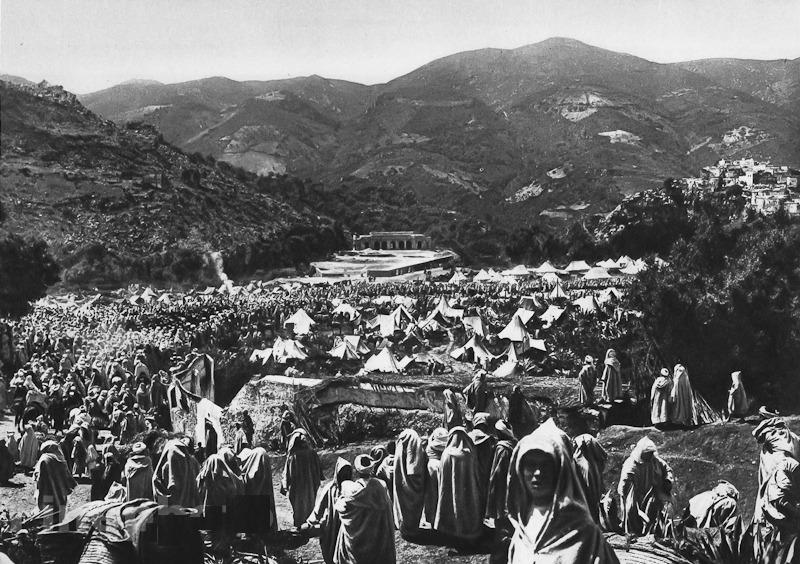
Moroccan Religion: Islam

Figure 1.--Here we ee Muslim pilgrims in Morocco durin 1924. We think it is Moulay Idriss, a Moroccan town and venerated religious site and for more than a millnium, place of pilgrimage. It is located just an hour outside of Fes. The city is named for the Moroccan saint Moulay Idriss, a descendant of Muhammad. He died and was buried there (792). The city was renamed in his honor. Idriss founded Morocco’s first Arab dynasty as well as the city of Fes and is responsible for converting the bulk of Morocco’s population to Islam.
|
|
Desert trinesmen fired by the Prophet Mohammed emerged from the Aabian Peninsula and defeated Byzantine armies, seizing the Levant and Egypt. Sunsequently, the Sunni Shi'a split developed in the east with the Shi's primarily prdominate in Persia (modern Iran) amd areas on he perifery of the Persian Gulf. The Arabs smashed Byzantine power in North Africa at Carthage (698). Other Arab armies seized all of North Africa to the Atlantic Ocean, including Morocco. The Berber tribes in North Africa had resisted the Romans and Btzantinesand also resisted the Aranbs, but Within a century, nearly all Berber tribes had bin Islamicized. Some of the Moroccan Berber tribes developed their own version of Shi’ism, which sparked rebellion against the dominate Suni Arabs controlling what is now Morocco. The Arabs had not only reached the southern shores of Europe facing Gibraltar, but launched an invasion of Spain. Arab armies had defeated Byzantine armies in the East, but the Byzantines still prevented an Arab invasion of Eastern Europe. That invasion would come in the West. After the conquest of North Africa, the Arabs and their Islamicized Berber Allies looked across the Strait of Gibraltar at the weak Visigoth kingdom of the Iberian Peninsula. Here a small Germanic ruling class had governed since the fall of the Roman Empire. Musa bin Nusayr, the governor of Muslim North Africa, dispatched his general, Tarik, and his largely Berber army on an expedition across the Strait (711) and proceed to conquer almosy all of the Iberian Peninsula. The conquest of the Levant, Mesopomsnia, and Persia in the east as well as North Africa and Spain in the west created the Caiphate. But almost as soon as it was created, centriphiacal forces of geography, distance, etnicity and dynastic desires began to tear the Caliphate apart. Local elites in Morocco established the Idrissid state with its capital at Fès (829) and controlled all of modern Morocco. This was the first of a series of Islamic dynasties, which included the austere Almoravids (1062–1147) who built their capital at Marrakesh and is stil an aw-inspiring sute, attracting Churchill and Roosevelt during Wotld War II. They would be called to defend Al Andalus during the Reconquista in Spain, but in the end destroy what had been one of the jewels of Islam. Next were the the Almohads (1147–1269), most famous for building the Koutoubia Mosque. Next were the Merenids (1269–1465). They were known for their beautiful mosques and madrassas (Koranic schools), most bnotably in Fes. Education at the madrasss focused on Islam and thus in Morocco and the rest of the Muslim world there was no Renaissance and birth of science and technology as in Christendom to the north. Instead of developing economies based on the new technologies. The Arab socieites turned to piracy, preying on the shipping of the increasingly prpsperous and modernizing Christian states,even launching slave gatering raids against coastal settlements. The Spanish expulsion of the Moors (1492) lent relgious justificatiom for the Barbary attacks. The Saadians seized control (1524–1659). Their most notable achievement was the Palais el-Badi in Marrakesh. The Alawites seized control (1659) and are the current ruling dynasty. Maoroccans were among the Barbary pirates, but less willking to challenge the Europeans and new American Republic. Thus the Barbary Wars were fought further east. Morocco resisted European colonization during the 19th century, primarily because of the competition betwen European powers (Britain, France, and Germany). France finally seized control, establishing protectorate just before World War I (1912). The French set up their administrative capital at Rabat and agreed to give Spain a token zone in the north. Berber mountain tribes resisted, but was supressed by the Foreign Legion if nevr totally eliminated. Eventually resistance to the French entered political channels with the Istiqlal (independence) party. Moroccan Islam was general more moderate than the Islam of the Arn heartland, especially the modern Wahabis. Unlike Muslim forces in Egypt, Iran, Iraq, and Palestine, Moroccan Muslims were not sympathetic to the NAZI Holocaust of the Jews pursued in Morocco by the Vichy regime.
HBC

Navigate the Boys' Historical Clothing Web Site:
[Return to the Main Moroccan page]
[Return to the Main Middle East and North African page]
[Return to the Main Islam country page]
[Introduction]
[Activities]
[Biographies]
[Chronology]
[Cloth and textiles]
[Clothing styles]
[Countries]
[Topics]
[Bibliographies]
[Contributions]
[FAQs]
[Glossaries]
[Images]
[Links]
[Registration]
[Tools]
[Boys' Clothing Home]
Created: 1:50 AM 12/21/2014
Last updated: 2:31 AM 12/21/2014



